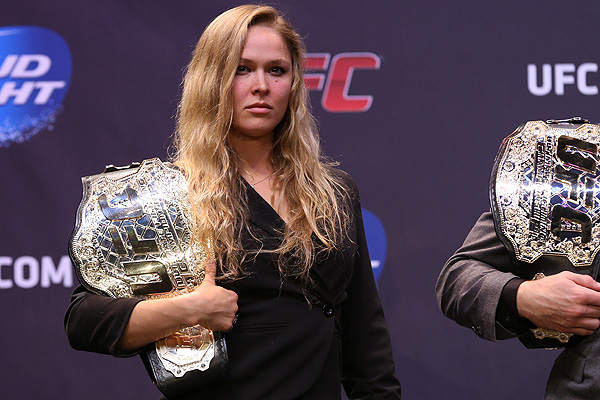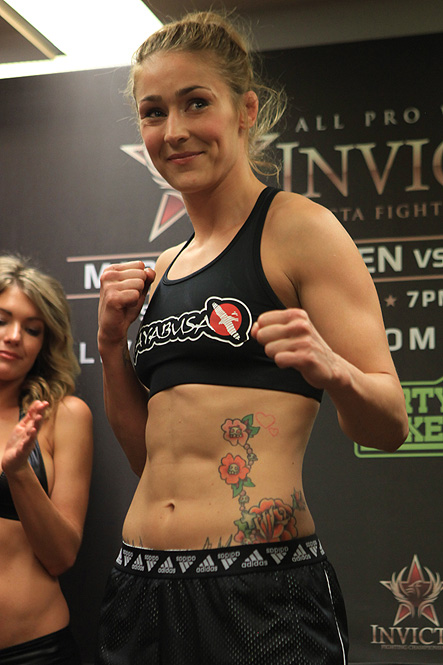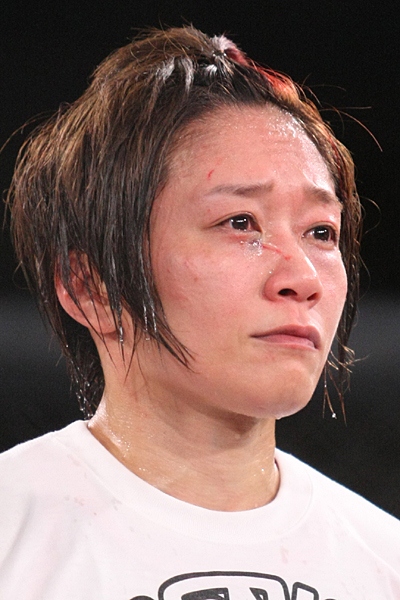Breaking Barriers
Struggle for Respect

Ronda Rousey has become the face of women’s MMA. | Photo: Dave
mandel/Sherdog.com
In her seminal work, “On Boxing,” Joyce Carol Oates is blunt about the condition of women’s prizefighting: “The female boxer ... she is parody, she is cartoon, she is monstrous.” Oates is correct in that this is how many idiots appraise female fighters. However, overwhelming historical evidence exists to suggest it is pure foolishness. The last 300 years indicate there is a considerable appetite to see great female battlers sweat, bleed and triumph, and it betrays this conventional ignorance.
If we hopped into a time machine and set the dial for June 23, 1722, we could open the London Journal and read about the first recorded prizefight between “two of the feminine gender.”
Advertisement
Spectacles of this nature, with fighters’ open challenges printed in the papers, remained commonplace until the Victorian Era’s straitlaced sensibilities rose in Britain. Fortunately, women of high social standing in the United States were dabbling in “genteel” sports like tennis, golf and archery. Eventually, female pedestrians and cyclists became famous, if only temporarily. This paved the way for another sect of sports stars: a new generation of female fighters.
The sudden public interest in female prizefighting was bolstered
and buoyed by National Police Gazette Editor Richard Kyle Fox, who
turned the simple gossip rag into an influential sports weekly. Fox
offered cash purses and championship belts to the day’s heavyweight
male boxers and eventually took to the same style of patronage and
publicity with women’s boxing, albeit on a smaller financial scale.
Women might make $20 a week as club fighters and perhaps a couple
hundred dollars for major bouts, which still represented a viable
alternative for those to which prostitution or factory work did not
appeal. It was not just boxing, either. Fox’s Gazette crowned Alice
Williams the first female world wrestling champion in 1891 after
she defeated Sadie Morgan at bareknuckle boxer Owney Beoghegan’s
Bastille of the Bowery sports club.
With combat sports’ popularity on the rise, boxing was added to the 1904 Olympic Games in St. Louis; women’s boxing was shown as a demonstration sport that same year. However, the developing realm of women’s sports was a mere afterthought when World War I broke out, and The Great Depression that followed only further enforced conservative gender relations. It would take nearly a half century for female athletics to reclaim a level of legitimacy and nearly three quarters of a century for female fighters to do the same.
The primordial soup of women’s MMA was coming to a boil by late 1995. The international success of the Ultimate Fighting Championship, as well as the domestic success of the Shooto-backed Vale Tudo Japan series, had an immediate impact on Japan’s professional wrestling landscape. When Japan Women’s Pro-Wrestling was disbanded due to political strife within the company in January 1992, its roster split along curious lines; the traditional, entertainment-oriented stars formed JWP Joshi Puroresu, while the martial arts-oriented “shooter” contingent, led by Rumi Kazama and Shinobu Kandori, broke away to create Ladies Legend Pro-Wrestling. LLPW, along with powerhouse All-Japan Women’s Pro Wrestling, were the first promotions to dare to stage vale tudo-style bouts involving women.
However, female MMA’s first true bellwether moment came on Dec. 5, 2000, as Neo Japan Ladies Pro-Wrestling staged the groundbreaking ReMix World Cup at Tokyo’s Nippon Budokan. The event was a 12-woman, one-night, legitimate MMA tournament for a prize of 10 million yen, or approximately $100,000 -- prize money that few established male fighters were getting at the dawn of the new millennium.

Photo: D.
Mandel/Sherdog.com
Coenen burst on the scene as a teenager.
Neo boss Daiki Shinosaki quickly retooled the ReMix series into a new promotion: Smackgirl. Though the post-ReMix landscape saw nearly every major Japanese fight company -- except, of course, industry leaders K-1 and Pride Fighting Championships -- attempt a female MMA brand, Smackgirl dominated the landscape until it closed in October 2008, introducing new Japanese stars such as colorful knockout artist Hisae Watanabe, submission dynamo Satoko Shinashi and wrestling ace Yuka Tsuji.
In Japan, the kakutogi boom of the early-to-mid 2000s had fans and casual television watchers glued to MMA, and the rising tide was lifting all boats, women included. Not all was perfect, however. Smackgirl’s smaller purse strings made it difficult to actualize dream bouts like a 115-pound showdown between champion Tsuji and then-pound-for-pound queen Megumi Fujii. Coupled with conservative rules, pillowy gloves and a nonsensical 30-second time limit on the ground, Smackgirl, despite its stability, was far from the ideal.
In the United States, no promoter has been more vital to female MMA’s development than Jeff Osborne. He is perhaps most recognizable for the time he spent in the UFC commentary booth, circa 2002, especially given his infamous deep monotone. Osborne started as a thin, ponytailed, would-be professional wrestler before realizing he would need to nearly double his body mass in muscle in order to become a star in the ring. As a result, he turned his efforts to MMA. From its humble home base in Evansville, Ind., Hook-n-Shoot became one of the sport’s most reliable, entertaining feeder promotions, largely due to his willingness to import international talent and to promote lighter weight fighters and women at a time when it was a distinct rarity.
On March 10, 2001, Osborne staged his first women’s MMA bout, as Judy Neff punched out Jessica Ross in the first round. Eleven months later, he served up the aptly titled “Revolution.” It was the first sanctioned all-female MMA card in the United States and quickly became must-see material for fight freaks and recalibrated many Western fans’ thoughts on women in mixed martial arts.
Osborne seldom made money from his shows. In fact, he often quipped that while most promoters promoted shows to make money, he made money to promote shows. That charitable, love-of-the-game nature came into play once more in 2006, when Osborne took a role within online gaming billionaire Calvin Ayre’s ill-fated Bodog Fight project.

Photo:
Keith Mills/Sherdog.com
Fujii carried the pound-for-pound torch.
Given that Bodog Fight was essentially a broken ATM machine hemorrhaging money, these women were able to get some tidy financial compensation, too.
At this same time, premium cable network Showtime and its sports division were also eager to try to ride the MMA wave. Showtime had already shown a desire to offer a product that could be equal parts thrill and titillation, as evidenced by broadcasting experiments such as “Perfect 10 Model Boxing.”
Given the lack of serious MMA free agents at the time, Showtime and its partners in Elite Xtreme Combat had to be creative. They relied on backyard fighting Internet sensation Kevin “Kimbo Slice” Ferguson and quintessential MMA anti-hero Nick Diaz, fresh off of his release from the UFC. They also turned to Gina Carano, who would become the first true face of women’s MMA after more than a decade-long search for such a muse.
The daughter of former Dallas Cowboys backup quarterback Glenn Carano, she became MMA’s “it girl” the moment she transitioned from muay Thai to the cage, with girl-next-door beauty and bona fide striking skills. Her professional debut, a 39-second knockout of Leiticia Pestova, was the first sanctioned women’s MMA bout in the state of Nevada. Six months later, she was in the antepenultimate bout on a Strikeforce card at the HP Pavilion in San Jose, Calif. Whether or not it was something she wanted, Carano became the center of the women’s MMA universe almost overnight.
At the first-ever EliteXC show on Feb. 10, 2007, Carano went from proposed postergirl to legitimate MMA star in the blink of an eye, courtesy of her 15-minute slugfest victory over a spirited-if-undersized Julie Kedzie. MMA forums and blogs immediately lit up with responses in the vein of, “I’d never watched a women’s fight before, but ...” or “I used to think women shouldn’t fight MMA, but ...” Those were Powerful, powerful buts.
Finish Reading » Even as the drumbeat for women having a greater place in MMA echoed loud, UFC President Dana White was resolute for years that women would never fight in the Octagon. Maybe it was bluster all along.
Related Articles






